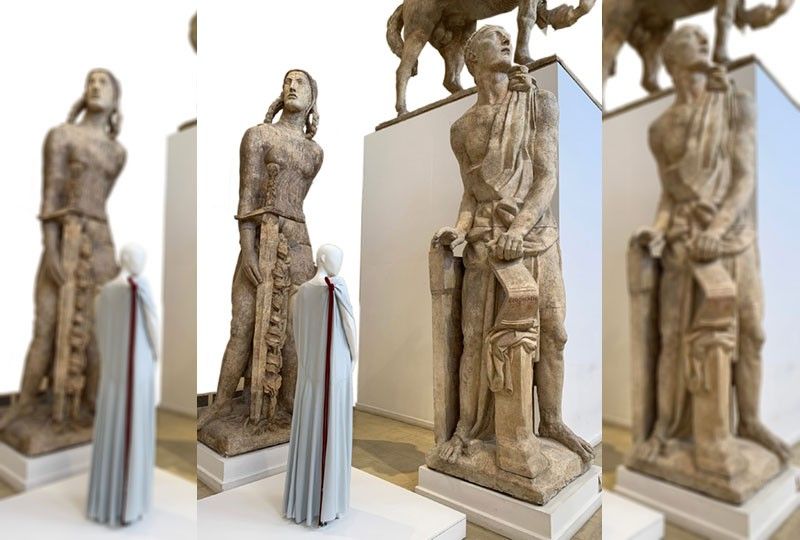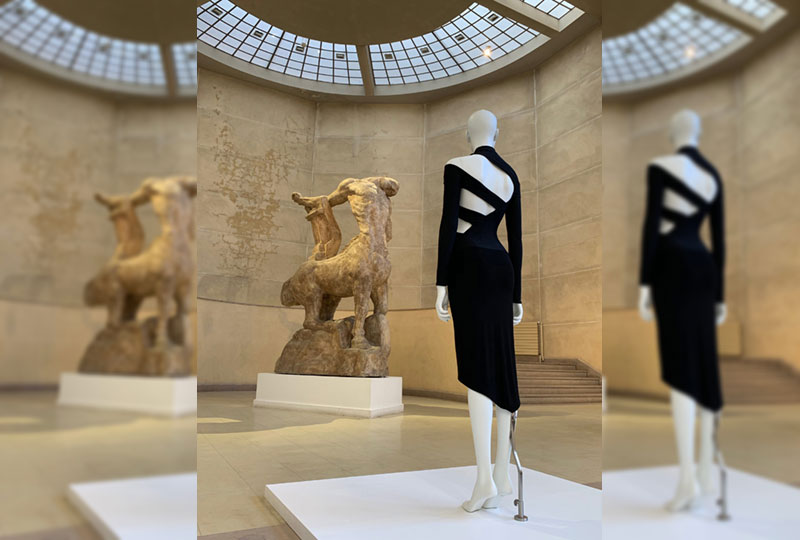The back story of fashion

Rita d’Acosta Lydig’s entrance at the Met Opera gala opening, or any opening for that matter, was always highly anticipated because she was known for introducing the latest fashions before anyone. The New York gratin at the Orchestra would eagerly await the moment when the socialite would remove her evening wrap to reveal a new style. On this particular evening, however, her entry was unremarkable since she was dressed in a simple black gown as she took a seat in her box. It was only during intermission when she stood up to address her party that the audience was stunned to see that her back was bared to her waist. The theater critic Frank Crowninshield, who was with her, reported that there was a collective gasp heard, followed by a wave of binoculars and lorgnettes being lifted to a thousand pairs of eyes. Newspapers the next day labeled the outfit and the wearer “scandalous” and “indecent.” At another opening, when Giacomo Puccini presented his opera La Fanciulla del West in 1910, the Italian composer couldn’t take his eyes off Lydig with her bare back, abandoning rich dowagers who had invited him and spending the rest of the evening behind the fashion icon’s private box “like some forlorn and hypnotized bird,’’ according to Cecil Beaton. Needless to say, it wasn’t long before the Lydig evening dress was copied by fashionable women all over the world. The back gained currency as a means of seduction; and by 1914, practically all the backs at the theater were bare. Lydig also became known as “the most picturesque woman in America.”
But even when the back was not bare, it was always a source of fascination as well as voyeuristic pleasure. The observer from behind can look without the pressure of engagement and without fear of any consequences. Unlike other parts of the body, the back may be a reminder of our limitations since it is hidden from view and to some extent, from touch. Still, fashion consistently embellishes it, burdens it, or reveals it. As the flattest part of the body, it becomes a canvas to display patterns and messages without our ever seeing the glances they attract.
Yet in this era of the selfie and its obsession with the face, the back always gets second billing — prompting the Palais Galliera in Paris to correct this injustice by mounting a comprehensive exhibit devoted to this part of the anatomy. “Back Side/Dos à la Mode,” ongoing at the Musée Bourdelle, “addresses our body’s relationship to clothing from a social and psychological point of view and questions our perception of our own as well as other people’s backs,” according to curator Alexandre Samson.
What distinguishes this exceptional exhibit of over a hundred pieces of clothes and accessories from the 18th century to the present is the dialogue between select garments and the sculpture of Antoine Borudelle, the influential sculptor of the turn of the 20th century. With the juxtaposition of fashion and art we get a chance to see both in a new light.

There is also the unparalleled setting afforded by areas of the museum like the vast Great Hall of Plasters with its monumental statues in stark contrast to the Swarovski beaded showerhead gown of Karl Lagerfeld for Chloé and “Thaïs” gown by Clare Waight Keller for Givenchy.
In the more intimate studios of Bourdelle, there’s Alexander McQueen’s silver rose corset, virtually a piece of modern sculpture amidst paintings and ecclesiastical art; and two pieces from Comme des Garçons by Rei Kawakubo, grotesque silhouettes in a room of classical pieces.
The exhibit proper is housed in the extension wing designed by Christian de Portzamparc. Jean-Julien Simonat designed the exposition to harmonize with the architecture, volumes and colors of the building, creating new depths of perspective. “Absent Back” greets viewers with a corridor of 3,524 images from 79 of the women’s SS2019 fashion shows taken from the internet but sadly, Samson observes, “Given the speed at which they are shown, only the frontal views are kept, neglecting the three dimensional nature of the body and its clothes.”
“In the Train of the Back” traces how the body’s natural forward motion allows fashion to use trains and volumes to extend the line of the outfit behind the back. A magnificent embroidered court train from an 1880 gown illustrates how, since the 13th century, the train has distinguished the rich and powerful — from 3 meters long for duchesses to 13 meters for French queens at Versailles. Russia’s Catherine II had a 14 m. train that required 12 valets to lift. In more manageable proportions, it featured in evening and wedding dresses of the 19th century. Unlike court trains, it did not represent the power of women but rather “isolated them and established the majesty of the union.” A century later, designers like Cristóbal Balenciaga and Yohji Yamamoto created experimental versions that incorporated volumes extending backwards. Less understated was Rihanna’s gown by Guo Pei with the longest train that quickly circled all the cities of the globe on the web, declaring her status as music and fashion empress at the Met Gala.

Backs, however, are often forgotten in fashion history as seen in the French men’s suit of the 18th century. where the justaucorps jacket was designed so that it did not need to be removed, prompting a waistcoat design that had a very elaborate embroidered front but a back made of “humble” materials like hemp. This is echoed in sculpture where bronze masks were made never to be looked at except from the front.
But when designers do indulge the back, dresses take flight through wings made of costly exotic feathers like Thierry Mugler’s 1984-85 “Winter of Angels” collection that had immense pairs of wings designed by the plumassier Lemarié.
In spite of the anatomical impossibility of reaching one’s back, laces, hooks, zippers and other fasteners have been devised for women since the Renaissance — an archaism during the time when women were dependent on a servant or a husband to dress themselves. In contrast, men’s clothes that close at the back are very rare, except for medical reasons like a straitjacket. In contemporary times, the oppressive design has been used for drama, as seen in Galliano’s sheath gown closed by 51 buttons.
A fashion cliché as it may have become, the bare back erotically fuels the imagination. Although more chaste at the end of the 19th century. with just the nape of the neck and the top of the back shown in most versions, after WWI more of the back was seen as sunbathing became commonplace with swimsuits revealing more and eventually extending to evening dresses. In the ‘30s when Hollywood films did not allow women’s breasts to be seen, ingenious ways were devised to show off the back, using straps, cuts and ties.
As the world became bigger and more interconnected, with people’s voices growing louder and more persistent, the back was not spared to relay messages and to express oneself. In the 1980s, fashion labels became aware of the promotional possibilities of the back, making it a medium to print names and logos and providing a way to recognize fellow members of an elite group. In reaction to logo mania, Martin Margiela affixed a simple white cotton rectangle, a sibylline logo that became a unifying sign for true fashion lovers. A recent piece from Zara worn by Melania Trump in 2018 offers a caveat for message-declaring garments. Printed with the sentence, “I really don’t care, do you?,” the parka was worn by the US First Lady for an official visit to a children’s refugee camp on the Mexican border, causing a barrage of tweets criticizing her insensitivity and the inappropriateness of the garment. She promptly tweeted back: “It’s just a jacket. There is no message.” Unfortunately, with a message on it, it’s no longer just a jacket. And when it’s worn by the wife of one of the biggest nations of the world, the message is loud and clear.
* * *
‘‘Back Side/Dos à la Mode’’ is ongoing until Nov 17. Visit www.bourdelle.paris.fr for details. Follow the authors on Instagram @rickytchitov; Twitter @RickyToledo23; Facebook - Ricky Toledo Chito Vijandre.



















